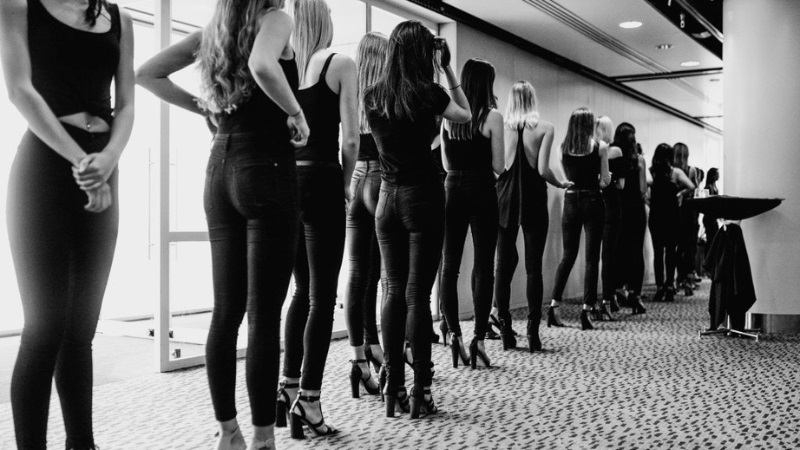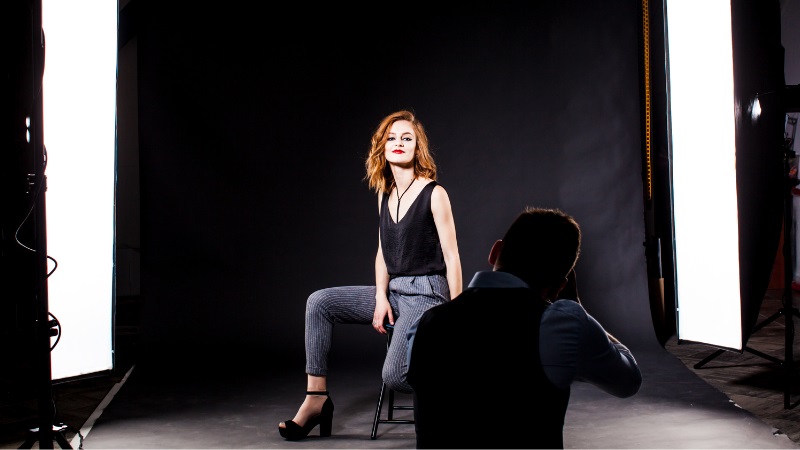
How to Become a Runway Model & Walk at Fashion Shows
Runway modeling certainly looks like a glamorous job. And this is true for the most part. Models enjoy dressing up, taking exotic trips, meeting famous people, and working with the biggest names in the fashion industry. But being a runway model is not always about the glitz and glam associated with the job.
Modeling is a highly demanding job that requires dedication and perseverance. You need to meet stringent physical requirements, work odd hours, and have a strategy for life after modeling. With the right strategy and experience, you can become a modeling coach or set up your own agency, especially if walking the runway is a short-term goal for you.
High-fashion modeling jobs are hard to come by. However, a solid plan and rigorous preparation will set you apart from your competitors. In this article, we outline the steps for becoming a runway model and respond to some frequently asked questions regarding this career path.
9 Tips for Becoming a Runway Model
Setting up a successful modeling career requires time and discipline. If you’re an aspiring model aiming to walk at the biggest fashion shows, check out the following tips:
1. Find a class that is a good fit for you
Whether it’s an online or in-person modeling class, finding training that teaches you all types of modeling and fits in your budget is the first step to becoming a successful model. You may prefer watching Youtube videos to learn about modeling but they will teach you bits and pieces which will confuse you and feel lost. A highly-rated online training such as the Modeling Master Course is an easy and affordable way to get started in modeling no matter what your height, age, body shape, location, or experience level is.
For in-person classes, we created a hand-selected list of modeling schools in the USA.
2. Identify your niche
As an aspiring model, it’s important to understand the many professional options open to you. To do this, spend time analyzing your appearance and body type. Take note of your best features and the market your looks cater to. Many fashion clients prefer tall models, but there may be clients with differing tastes.
Consider researching local brands and organizations to find out more about their unique needs. For runway modeling, designers have very particular body measurements and height requirements. If you find these requirements physically unattainable, do not get discouraged. If modeling is your passion, there are other options available to you. Look out for our FAQ section, we’ve discussed these options in greater detail.
3. Understand the job
Modeling requires hard work and determination. Some of the many duties of this job include the ability to follow orders, pose in particular ways, and spend hours recreating a look.
Based on the kind of modeling you want to do, you’ll need a wide range of poses in your arsenal. You’ll also need to understand how to position your body and face the camera to capture the right image. Lastly, to walk the runway, you must develop and perfect your signature walk.
4. Take care of your health
Modeling is all about aesthetics, but being attractive isn’t the most important part. Since modeling focuses on your physical attributes, it’s important to take care of your body and general health. Although there are more modeling opportunities for various body types, you still have to take care of your skin, hair, and nails.
Consider planning a routine that promotes wellness. For instance, you can arrange a specific time to work out or go to bed. Getting appropriate sleep and staying hydrated is crucial. For skin and hair, you may develop a routine that’s best suited to you.
5. Practice posing
Everyone has a ‘side’ of their face they prefer – models are no different. Knowing your body angles and posing in a flattering way can help you succeed as a model. Each person is different, so practice in front of a mirror to understand your best angles and how your body moves.
Set aside sometime each day to practice body movement and experiment with different expressions. Working with an experienced photographer helps you get constructive feedback and insight into the modeling industry’s needs.
If all of this seems too daunting to do on your own, look into modeling schools. Modeling classes will help you understand the basics of what this career entails, like how to compose your photo portfolios, how to pose or runway walk, how to work with photographers, and personal image development.
6. Improve your runway model walk
As an aspiring model, your walk is just as important as your pose. Spend time watching videos of fashion shows. Take note of how some of the most popular models in the world walk and hold the audience’s interest. Afterward, practice walking to different beats and rhythms. Repeat this process until you can confidently and comfortably adjust your movements to match various tempos.
If you’re looking for a crash course on how to perfect your walk. Here are some tips to get you started.
- Don’t walk too fast or too slow, keep a steady pace
- Maintain a neutral expression
- Place one foot in front of the other and walk with long strides
- Keep your arms relaxed and allow them to swing only slightly
- Pick a walk style: predator, attitude, march
- Strike your pose at the end of your walk
7. Get headshots
To get a modeling job as a runway model, you’ll need various headshots and full body shots to submit to agencies and potential employers. When submitting headshots, it’s important to stand out amongst the crowd. Otherwise, your photo will just get lost among the hundreds of headshots agencies receive on a daily basis.
To ensure you’re submitting your best work, hire an experienced photographer to shoot you in natural light. Wear plain clothes and colors to highlight your features. Go for no-makeup looks so that your pictures closely resemble how you look in real life.
8. Build your portfolio
Your portfolio is the very first thing potential clients look at to determine if you fulfill their vision. Whether in digital or physical format, your portfolio should only feature your best work.
Include a range of photos that capture from various angles to help clients see your full potential. Think about incorporating headshots, photos of your entire physique, and pictures of you in various stances and moods.
Remember, these photos are more styled and edited than your headshots. So wear fancier clothes and pose with a glamorous backdrop. Once you have all your photos ready, organize them into a portfolio or on a website to advertise your abilities and range.
9. Find a modeling agency that fits your style
Most models who hope to make it big seek agency representation. Research the top modeling agencies in your area to better understand the kind of models they represent and the clients they have access to.
To determine if an agency is reliable, check for reviews, testimonials, or press releases. Once you’re content with the result, submit your portfolio and any relevant modeling experience. If a company schedules a face-to-face meeting with you, be sure to be on time, project confidence, and dress in flattering attire. Modeling Master Course explains how to find modeling agencies and how to pass auditions to get selected.
Frequently Asked Questions about a Modeling Career
Below are answers to some commonly asked questions about a modeling career:
What are the different types of models?
While runway modeling may be your first pick, there’s no harm in exploring other opportunities in the fashion world.
- Editorial model: Editorial models most commonly appear in fashion magazines, wearing the latest fits by top designers. Clients typically require similar measurements to those of a runway model but may be more lenient when it comes to height.
- Catalog model: More commonly known as commercial models, these models resemble the average person and are hired to sell clothes to the general public.
- Fitness model: Fitness models are required to maintain peak physical fitness. They usually appear in fitness-related magazines and advertisements.
- Body parts model: As the name suggests, a body parts model only models a specific body part, such as hands or feet.
- Plus-size/Petite model: Plus-size models are larger than the editorial standard. These models wear plus-size clothing which can vary for each designer. Petite models, on the other hand, don shorter clothing. These models are typically under 170 cm and may wear a variety of designs ranging from every day to high-fashion.
For more information about different modeling types, check out 19 types of modeling.
How to become a model for New York/Los Angeles fashion shows?
There’s no fashion week without New York Fashion Week (NYFW) and Los Angeles Fashion Week (LAFW). To walk in NY and LA fashion shows you have to follow a proper strategy to stand out from the crowd and get noticed. Here’s a 3-step strategy to help set your modeling career in motion:
- Build Industry Connections: Becoming a high-fashion model is not everyone’s cup of tea. You need meaningful industry connections to get a chance to walk on the ramp. Search for upcoming industry-specific events and use them to converse with people of your niche. This will help you build professional networks within your industry, plus there’s also the possibility of being seen by modeling scouts.
- Seek Out Small Designers: Every model wants to share the ramp with top models like Gigi Hadid and Kylie Jenner. Thousands of models try their luck but only a few get the chance to model for big brands. A better approach to becoming a NY/LA model is to approach small designers. These designers have a limited budget, thereby giving you a higher chance to get selected for their projects.
- Subscribe to Online Platforms: Modeling platforms like Backstage and Latitude Talent send you details about the latest fashion shows and modeling events. Besides details, these online platforms also give expert advice on how to get cast. The monthly subscription fee of these platforms amounts to 20$, so be sure to check the history of such a platform before joining.
- Learn From Experienced Coaches: The well-known online training program, Modeling Master Course, teaches different types of walks preferred at popular fashion shows and shares a guideline to get booked in these shows.
Conclusion
While you can’t learn all about modeling over the internet, we hope this article was a good start. Like any career, it’s important to have realistic expectations and goals. Modeling is not an industry that grants instant stardom. It is an investment you need to keep adding to, whether it’s learning a new skill, taking workshops, or just diversifying your portfolio. Building your skills gradually will ultimately lead you to become a successful runway model. So, be patient, keep positive, and find new ways to get noticed even if that means going out of your comfort zone.




